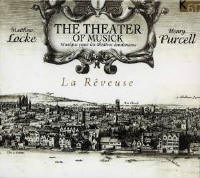Texte paru dans: / Appeared in: |
|
| Appréciation d'ensemble / Overall evaluation : | |
|
Reviewer: Jonathan
Freeman-Attwood Rare gems in a gratifying exploration of Restoration theatre music
In an ingenious fashion, the tight-knit French Baroque ensemble La Reveuse presents a programme celebrating a period of almost peerless economic growth in London reflected in an age of theatrical luxuriance which, indeed, even impressed the French and led to a fin de siècle momentum all of its own. Assembled from miscellaneous sources of the period, "The Theater of Musick" draws together a quixotic programme of pieces by Matthew Locke, the boldest and best of the music-theatre composers of the day, until the arrival of his (perhaps) protégé, Henry Purcell, who unsurprisingly takes most of the limelight here. The expressive fusion of age-old contrapuntal pungency and the new-found textural airiness of the English Restoration have not always presented an easy challenge for continental groups, where poor diction, misplaced declamation and too much "courtly" panache have sieved out the essential grittiness and unpredictability in the music. The instrumental group of La Rêveuse is richly resonant, tautly coherent and capable of imbuing the music with energy and elegance. The sarabands, in particular, capture the dark fantasy in the sinews of Locke's lines. The singing of the soprano Julie Hassler is more variable. The simple vernacular of James Hart's "Adieu to the Pleasures" (from Locke's music for Shadwell's Tempest in 1674) is delightful and the nocturnal musings of Purcell's "So! when the glitt'ring Queen of Night" mysterious and dignified. Diction and intonation, however, are an intermittent problem in some of the other songs. If the great "Curtain Tune" from The Tempest (a piece in which Locke introduces dynamics and memorably bold expression marks) is short on visceral immediacy in the playing, one is still struck by the heady harmonic language. Through this brilliantly juxtaposed compilation, we are afforded a fresh insight into many lesser known gems of the English mid-Baroque. |
|
|
|
|
|
Cliquez l'un ou l'autre
bouton pour découvrir bien d'autres critiques de CD |
|



